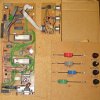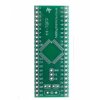MichaelaJoy
Active Member
Hi all,
Firstly, I wanted to post this link, which demonstrates what a keytar is.
http://keyboardkraze.com/best-keytar-2018-wired-wireless/
They give a good explanation, but what they don't tell you is that the Alesis key action leaves a lot to be desired.
I have the vortex 1 and, apart from nice functionality, the keybed is horrible.
So I did some shopping and I found the Roland A49.
http://www.sweetwater.com/store/detail/A49BK--roland-a-49-keyboard-controller-black
(Good people over there. )
)
The keyboard action is nice and the connectors from the keybed seem to be standard connectors.
Now I know that some people are thinking "why don't you just repackage the A49.".
Yeah...I could do that. But I think it would be more fun to build a microcontroller project that could easily interface to any double-action keybed.
Or possibly a pair of them.
Take a look at this link.
http://www.openmusiclabs.com/learning/digital/input-matrix-scanning/keyboard/index.html
This article gives a good explanation of how a keybed works.
So I picked up a pair of PIC 18F452 and a pair of PIC 24FV32KA302. I have the crystals for them and am awaiting the final parts.
I'm thinking that the 24FV32KA302 should be adequate to perform this task. It's through-hole, which is easier to work with than SMDs.
(At least for me it is.)
I found this site because I was looking for an example of using MPLAB-X with the 24FV32KA302. I found a thread over here, so I joined.
I'd like to avoid using C to do it, but if I have to use C, I will. My greatest concern is not knowing anything about the run-time library, and having
no idea how the lack of optimization (in the free version) will affect the timing. Also, I'd like to figure out how to write it in PIC assembler.
I think it would be a great bit of knowledge to have available here.
Needless to say, I welcome all input. I'd also like to make the source code freely available, so that others can take advantage of the tech.
Let the games begin
Firstly, I wanted to post this link, which demonstrates what a keytar is.
http://keyboardkraze.com/best-keytar-2018-wired-wireless/
They give a good explanation, but what they don't tell you is that the Alesis key action leaves a lot to be desired.
I have the vortex 1 and, apart from nice functionality, the keybed is horrible.
So I did some shopping and I found the Roland A49.
http://www.sweetwater.com/store/detail/A49BK--roland-a-49-keyboard-controller-black
(Good people over there.
The keyboard action is nice and the connectors from the keybed seem to be standard connectors.
Now I know that some people are thinking "why don't you just repackage the A49.".
Yeah...I could do that. But I think it would be more fun to build a microcontroller project that could easily interface to any double-action keybed.
Or possibly a pair of them.
Take a look at this link.
http://www.openmusiclabs.com/learning/digital/input-matrix-scanning/keyboard/index.html
This article gives a good explanation of how a keybed works.
So I picked up a pair of PIC 18F452 and a pair of PIC 24FV32KA302. I have the crystals for them and am awaiting the final parts.
I'm thinking that the 24FV32KA302 should be adequate to perform this task. It's through-hole, which is easier to work with than SMDs.
(At least for me it is.)
I found this site because I was looking for an example of using MPLAB-X with the 24FV32KA302. I found a thread over here, so I joined.
I'd like to avoid using C to do it, but if I have to use C, I will. My greatest concern is not knowing anything about the run-time library, and having
no idea how the lack of optimization (in the free version) will affect the timing. Also, I'd like to figure out how to write it in PIC assembler.
I think it would be a great bit of knowledge to have available here.
Needless to say, I welcome all input. I'd also like to make the source code freely available, so that others can take advantage of the tech.
Let the games begin



